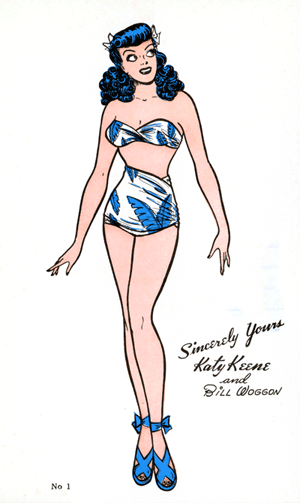



But now, as she launches into
her golden years, there are signs that Katy is set for another revival:
each day more fan sites pop up, the
E-Bay price of old issues of Katy Keene rises and Woggon’s grandson,
Jerico, has launched a web site (cherrymeltdown.com), along with his
own art career. And according to Jerico, modern audiences have a lot
to learn from the 1950s icon, “From Katy, people can re-connect
with a sophisticated woman with old-fashioned values and etiquette. Reading
Katy, it’s like immersing yourself in the good old days, and the
way things were.” As nostalgia for the last century’s fashions
continues to soar and rumours of a Katy Keene movie fly, the time seems
ripe for “America’s Dream Girl” to finally reclaim
the national stage.
MY DAD DRAWS ALL DAY
But behind every great comic book character, is a great cartoonist.
So, who was Bill Woggon and how did a Christian, family man from the
Midwest so successfully capture the fantasies of a fashion-obsessed 1950s
teen-ager?
The answer is that Bill Woggon’s life, like that of so many of us,
was filled with many quirky idosyncracies and ironies. To begin to understand
the extent of his dualistic life, first imagine his art studio during the
Katy Keene years. From inside a small, converted horse stable set amid the
stunning foothills of Santa Barbara County on Woggon Wheel Ranch, Woggon
created a parade of colorful, glamorous fashion designs. As Woggon’s
daughter Susie Bothke remembers, the studio “was not real advanced
by modern standards. There was a drawing board for dad and each of his assistants,
and filing cabinets. He kept clippings for ideas. There was something to
hold pens or pencils in. And there was all that [necessary cartoonist] stuff:
rubber cement and erasers. It was a working place.” For Woggon, there
was no aparent clash between the fashion-filled extravagance of Katy’s
life and the rough texture of his art studio, just as there seemed
nothing odd about his religious beliefs and subject matter, age versus the
age of
his audience, or his choice to work as a full-time artist and cartoonist.
His family seems to have accepted all of his quirks and habits without
question.
After all, that was just Dad. For Woggon’s children, Susie Bothke and Bill
Woggon, Jr., they grew up thinking that Dad’s job as a full-time cartoonist
was normal. There’s even a special Woggon family legend that backs this
notion up. As Bill Woggon, Jr. said, “During show and tell in second grade,
I was asked what my dad did for a living. I remember saying that my dad just
sits at home and draws.” It wasn’t until Katy Keene enjoyed a nostalgic
re-emergence in the 1970s that Woggon’s son realized the extent of his
father’s influence and popularity. For daughter, Susie, the recognition
of her dad’s achievements came when he was honored in at the San Diego
Comic Convention, the comic book industry’s largest annual gathering and
pow wow . There, as people clamored to get her autograph after finding out that
she was the inspiration for the “Sis the Candy Kid” character, Bothke
realized how many people had been touched by her father. Still, despite his massive
contributions to the world of cartoon art, it is Bill Woggon’s spirit,
not Katy Keene, that burns deepest in their memories of Susie, Bill, Jr., and
Jerico. As Bothke remembers, “He was a comfortable person for everyone
to be with. He was stable. [He liked] including us as a family. He would bring
out the best thought about each person.” Bill Woggon may not have been
as glamorous as Katy Keene, but his spirit showed a depth and sincerity lacking
in today’s society. Hey, there’s the perfect idea for the next succesful
comic book: it could feature a super hero named Bill Woggon, otherwise known
as Humble Man. Think it could fly?